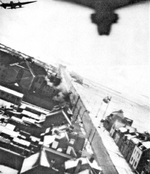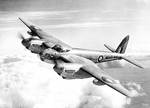Mosquito
| Country | United Kingdom |
| Manufacturer | de Havilland Aircraft Company |
| Primary Role | Light Bomber |
| Maiden Flight | 25 November 1940 |
Contributor: C. Peter Chen
ww2dbaseThe spruce-and-balsa wooden Mosquito multi-role aircraft were designed as fast light bombers that could outrun pursuing hostile fighters; because of their light weight and high speed, they were also used as fighters when necessary. Although the original design was released in 1938, it was not until 1940 when the British Air Ministry took notice of the wooden aircraft. When the German airmen faced these aircraft, they were amazed by their speed and their ability to protect the airspace over Britain. "In 1940 I could at least fly as far as Glasgow in most of my aircraft, but not now!", said Hermann Göring, commander of the Luftwaffe, in Jan 1943. "It makes me furious when I see the Mosquito. I turn green and yellow with envy." What made Göring and the rest of Germany most envious was de Havilland's ability to construct a capable aircraft out of material as common as wood at a time when iron and steel was in great demand. The most numerous variant was the Mk.IX that served as a high altitude bomber, encouraged by the result of a Royal Air Force cost-benefit analysis: throughout the entire war, the Mosquito bombers enjoyed the lowest loss rate, while it dealt far greater damage to the Germans when compared to the larger and more expensive Lancaster bombers. During its service, 7,781 Mosquitos were built, with 6,710 of them during the war. A significant fraction of that number came from Commonwealth nations such as Canada and Australia. During the war, Mosquito bombers were responsible for dropping 35,000 tons of bombs at a loss of only 193 aircraft.
ww2dbaseSource: Wikipedia.
Last Major Revision: Apr 2006
Mosquito Timeline
| 25 Nov 1940 | The prototype of the de Havilland DH.98 Mosquito unarmed light bomber was flown for the first time from Hatfield Aerodrome, Hertfordshire, England, United Kingdom. The aircraft was flown by Geoffrey de Havilland, accompanied by engineer John E. Walker. |
| 2 Jun 1941 | The British RAF took delivery of the first Mosquito PR 1 photo-reconnaissance aircraft. With double the range of the streamlined Spitfire photo-reconnaissance aircraft, by early 1942 UK-based Mosquito aircraft would be regularly flying photo-reconnaissance missions as far away as northern Norway, Ostpreußen (East Prussia) in Germany, and the north of Italy. |
| 17 Sep 1941 | The first operation conducted by a British Mosquito aircraft was launched to take photographs of German-controlled ports. |
SPECIFICATIONS
Mk.II
| Machinery | Two Rolls-Royce Merlin 21 engines rated at 1,230hp each |
| Armament | 4x20mm Hispano cannons, 4x0.303in Brownings |
| Crew | 2 |
| Span | 16.52 m |
| Length | 13.57 m |
| Height | 4.66 m |
| Weight, Empty | 6,396 kg |
| Weight, Loaded | 7,938 kg |
| Speed, Maximum | 595 km/h |
| Service Ceiling | 10,520 m |
| Range, Normal | 2,990 km |
Mk.IV
| Machinery | Two Rolls-Royce Merlin 21 engines rated at 1,230hp each |
| Armament | 4x20mm Hispano cannons, 4x0.303in Brownings, 4x227kg bombs |
| Crew | 2 |
| Span | 16.52 m |
| Length | 13.57 m |
| Height | 4.66 m |
| Weight, Empty | 6,396 kg |
| Weight, Loaded | 10,206 kg |
| Speed, Maximum | 595 km/h |
| Service Ceiling | 10,520 m |
| Range, Normal | 2,990 km |
Mk.IX
| Machinery | Two Rolls-Royce Merlin 72 engines rated at 1,680hp each |
| Armament | 4x20mm Hispano cannons, 4x0.303in Brownings, 4,000lb of bombs or extra fuel |
| Crew | 2 |
| Span | 16.52 m |
| Length | 13.57 m |
| Height | 4.66 m |
| Weight, Empty | 6,895 kg |
| Weight, Loaded | 11,340 kg |
| Speed, Maximum | 684 km/h |
| Service Ceiling | 12,190 m |
| Range, Normal | 2,990 km |
Photographs
 |  |  |  |
Você gostou deste artigo ou achou este artigo útil? Se sim, considere nos apoiar no Patreon. Mesmo USD $1 por mês já vai longe! Obrigado. Por favor, ajude-nos a espalhar a palavra: Fique atualizado com WW2DB: |
Visitor Submitted Comments
13 Jan 2020 06:23:10 AM
I believe that the maiden flight of the prototype Mosquito constructed at Salisbury Hall, London Colney in November 1940 was from an adjacent field, not from Hatfield Aerodrome as stated on your website. A photograph taken there prior to this flight is shown in the HistoryNet article on the Mosquito aircraft at: https://www.historynet.com/the-miraculous-mosquito.htm
All visitor submitted comments are opinions of those making the submissions and do not reflect views of WW2DB.

- » Köln/Cologne Evacuated After Discovery of WW2 Bombs (4 Jun 2025)
- » US Women's Army Corps "Six Triple Eight" Awarded with Congressional Gold Medal (30 Apr 2025)
- » Wreck of Soviet Submarine M-49 Found (10 Apr 2025)
- » Japanese Emperor Visited Iwoto (Iwo Jima) (8 Apr 2025)
- » Race, Holocaust, and African-American WW2 Histories Removed from the US Naval Academy Library (7 Apr 2025)
- » US Government Plans to Purge WW2 Information (17 Mar 2025)
- » Ver todas as notícias
- » 1,171 biographies
- » 337 events
- » 44,911 timeline entries
- » 1,245 ships
- » 350 aircraft models
- » 207 vehicle models
- » 376 weapon models
- » 123 historical documents
- » 261 facilities
- » 470 book reviews
- » 28,521 photos
- » 365 maps
Winston Churchill, 1935
Por favor, considere nos apoiar no Patreon. Mesmo R$1 por mês já faz uma grande diferença. Obrigado!
Ou, por favor, nos apoie adquirindo alguns produtos do WW2DB na TeeSpring. Obrigado!
22 Aug 2010 11:46:59 AM
The Mosquito Mk XVIII carried a 57mm cannon
and four 303 caliber machine guns. The cannon was 1,800lbs/815kgs in weight, and
each round for the cannon was 7lbs/3.2kgs in weight.
Twenty five rounds for the cannon was carried
and with an automatic-loader, could fire all
twenty five rounds in twenty seconds!
Twenty seven aircraft were fitted with this
weapon, However it was found out that two
500lb bombs, or eight 60lb rockets were found
to be better suited.